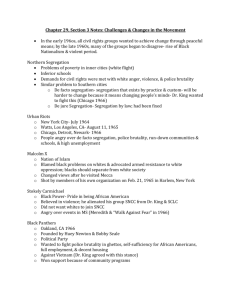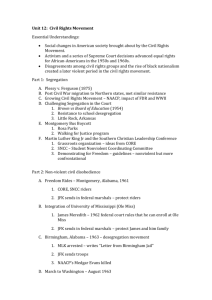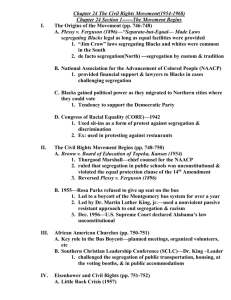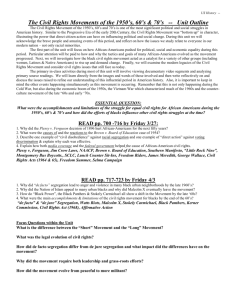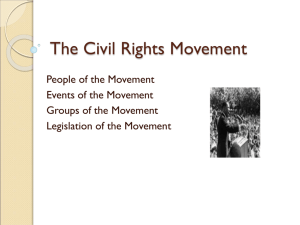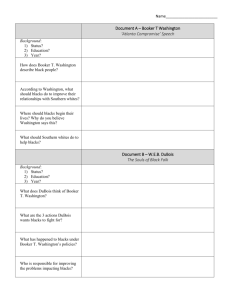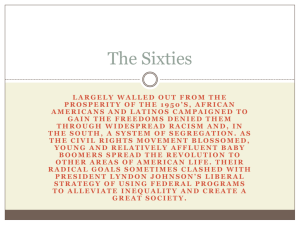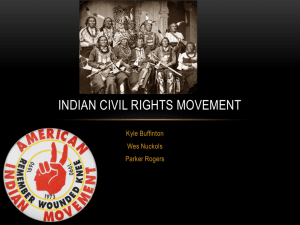Chapter 28 – The Civil Rights Era
advertisement
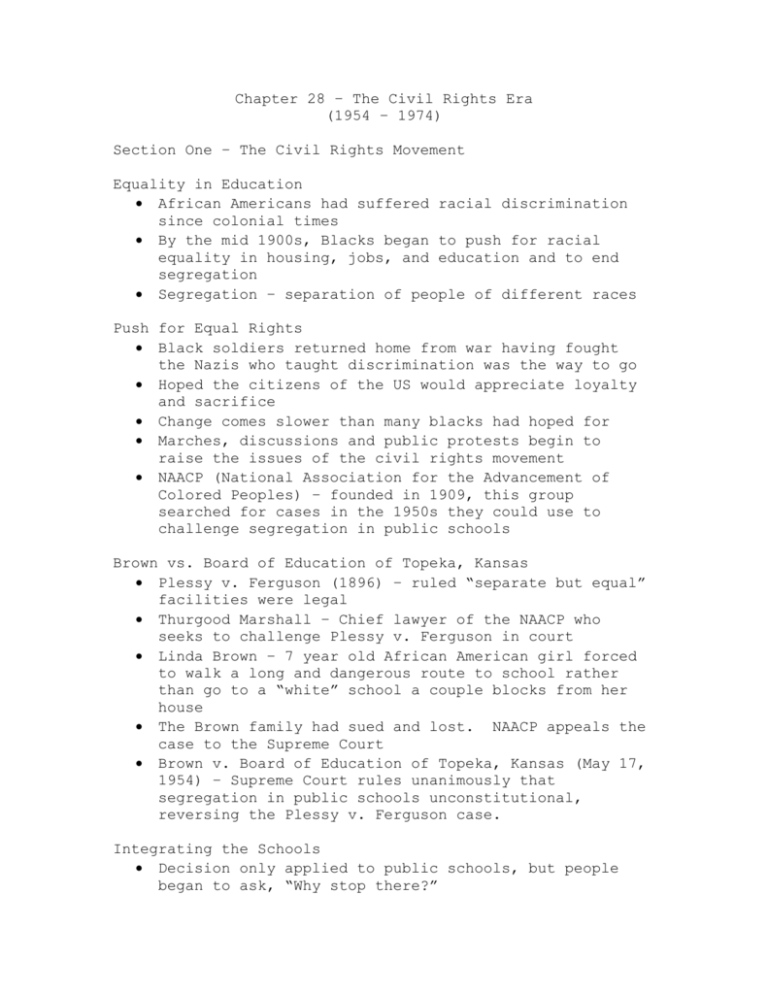
Chapter 28 – The Civil Rights Era (1954 – 1974) Section One – The Civil Rights Movement Equality in Education African Americans had suffered racial discrimination since colonial times By the mid 1900s, Blacks began to push for racial equality in housing, jobs, and education and to end segregation Segregation – separation of people of different races Push for Equal Rights Black soldiers returned home from war having fought the Nazis who taught discrimination was the way to go Hoped the citizens of the US would appreciate loyalty and sacrifice Change comes slower than many blacks had hoped for Marches, discussions and public protests begin to raise the issues of the civil rights movement NAACP (National Association for the Advancement of Colored Peoples) – founded in 1909, this group searched for cases in the 1950s they could use to challenge segregation in public schools Brown vs. Board of Education of Topeka, Kansas Plessy v. Ferguson (1896) – ruled “separate but equal” facilities were legal Thurgood Marshall – Chief lawyer of the NAACP who seeks to challenge Plessy v. Ferguson in court Linda Brown – 7 year old African American girl forced to walk a long and dangerous route to school rather than go to a “white” school a couple blocks from her house The Brown family had sued and lost. NAACP appeals the case to the Supreme Court Brown v. Board of Education of Topeka, Kansas (May 17, 1954) – Supreme Court rules unanimously that segregation in public schools unconstitutional, reversing the Plessy v. Ferguson case. Integrating the Schools Decision only applied to public schools, but people began to ask, “Why stop there?” Brown v. Board angered white Southerners, who began to more aggressively defend segregation Integration of schools was to occur in schools “with all deliberate speed” – this created a problem because of no set time Confrontation in Little Rock Central High in Little Rock, Arkansas was to be integrated in 1957. Governor Orval Faubus opposed integration and called the National Guard to stop blacks from entering the school. Little Rock Nine – nine black students registered to attend in September, but met strong white resistance States Rights – for the first time since the Civil War, a state defied the federal government – cannot do this. Eisenhower sends hundreds of troops to protect the Little Rock Nine Montgomery Bus Boycott Rosa Parks – a member of the NAACP, Parks refused to give up a seat on a bus on December 1, 1955 and fined $10. Boycott – refusal to buy or use a product or service Rev. Dr. Martin Luther King – an unknown, Baptist preacher, King calls for blacks to boycott the buses. Very effective and lasts over a year until Supreme Court bans segregated busing. Nonviolent Protest Civil disobedience – refusal to obey unfair laws. Taught by Gandhi in its fight against Great Britain for Indian freedom Dr. King and others urged members of the Civil Rights Movement to refuse violence no matter what happened to them. Very effective as people watch white attack protesters on television who are doing nothing. Section Two – Kennedy and Johnson A New President Election of 1960 –Dem. John F. Kennedy defeats Rep. candidate Richard Nixon Televised debates probably gave JFK the win as he looked young and healthy (make-up) vs. Nixon (recovering from illness and sweaty under lights) Kennedy’s Inaugural – “Ask not what your country can do for you, but what you can do for your country.” Kennedy’s Domestic Policies New Frontier – more federal aid for education and the poor Supported Civil Rights but didn’t get anything passed (inexperienced leader) Kennedy Assassinated November 22, 1963 – JFK in a parade with wife, Jacqueline when shots rang out. JFK was killed and Vice-President Lyndon B. Johnson became president Lee Harvey Oswald accused of the murder, but shot before a trial could be held. The Great Society Lyndon B. Johnson wanted to do several things o Reduce poverty o Promote equality o Rebuild decaying cities LBJ was an excellent politician who was in Congress for 22 years and knew how to get things passed in Congress – quietly and behind-the-scenes Medicare (1965) – established a health insurance program for the elderly paid for through Social Security Medicaid (1965) – provides health and medical assistance to low income families Johnson was a southerner but supported civil rights for all Americans Civil Rights Act of 1964 – o Banned discrimination in employment, voting, and public places o Not only banned racial discrimination, but gender, religious, and national origin Section Three – The Struggle Continues The Movement Grows Sit-ins – the act of protesting by sitting down. Sitins were used across the country to protest restaurants and other places that required segregation Student Non-Violent Coordinating Committee (SNCC) – students who took part in many protests including sitins. One of its leaders was John Lewis, now a Congressman from Georgia. Freedom Rides Black and white students decided to ride two buses in the south to see if bus desegregation was being enforced in 1961. Freedom Riders met violence in Alabama as they challenged local Jim Crow laws. Television and newspapers showed violence against them and many people in the US were sickened to see young people being attacked Interstate Commerce Commission begins to enforce the Supreme Court’s bans on segregated interstate buses and bus stations Integrating Universities James Meredith – Black student who wanted to enroll in the University of Mississippi (Ole Miss). Governor of Mississippi Ross Barnett keeps Meredith out President Kennedy sends federal marshals to help Meredith and violence breaks out – two killed Meredith registers and graduates in 1963 (troops remained with him for protection) Birmingham Spring of 1963 – Dr. Martin Luther King targets Birmingham, Alabama for desegregation protest. Civil disobedience - Hundreds, including King and many children, arrested. Those arrested took this as a sense of pride – not willing to follow unfair laws. King writes “Letter from a Birmingham Jail” while in prison for two weeks Police use fire hoses and attack dogs to stop demonstrations Television captures the images of children being attacked by police and angry mobs and creates sympathy for protesters Kennedy sends 3000 troops to restore peace Medgar Evers – an NAACP official, he was murdered on June 11, 1963. March on Washington August 28, 1963 – 200,000 people meet at the Lincoln Memorial to hear speeches by King and others People of all colors from all over the country come No trouble and very peaceful, joyous crowd People carried signs, sung songs, and pushed the idea o peace and equality “We Shall Overcome” – the anthem of the Civil Rights Movement King delivers the “I Have a Dream Speech” Freedom Summer (1964) President Lyndon B. Johnson passes the Civil Rights Act of 1964 Civil Rights Act of 1964 o Outlaws discrimination in hiring o Ended segregation in stores, restaurants, theaters, and hotels Civil rights workers spread through the south to help blacks register to vote Many states still have poll taxes and other ways to stop blacks from voting The Right to Vote In 1965, SNCC organizes a demonstration in Selma, Alabama to protest denial of blacks’ right to vote John Lewis and about 60 others decide to march from Selma to Montgomery, AL to protest Bloody Sunday (March 9, 1965) - After crossing the Edmund Pettis Bridge, the group was met the Alabama State Police who chased them back using tear gas and nightsticks President Johnson steps in and in a televised speech, told America “We shall overcome,” and urged the Congress to pass a voting rights bill Voting Rights Act of 1965 – Federal government can force local officials to allow African Americans the right to vote. Leads to great changes. 1966 – 100 blacks hold elected offices in Southern states By 1972, there were 1000 blacks in elected offices Other Voices Malcom X – sought separation an independence for blacks at first. By 1965, however, he began to see that integration could work and was killed by his former followers Black Power – philosophy of racial pride that said blacks should create own culture and political institutions. Very radical and popular among poor urban neighborhoods but rejected by larger groups such as the NAACP. Stokley Carmichael was main advocate. Black Panthers – Young radicals led by Eldrige Cleaver who demanded reforms and armed themselves. Had several violent clashes with police. Violence Erupts Watts Riot – Summer, 1965 – In Los Angeles, 34 killed in one week of rioting Several others follow in 1965 – 1967. Dr. King Assassinated April 4, 1968 – Martin Luther King shot and killed in Memphis, Tennessee Sets off riots in 100 cities Section 4 – Other Groups Seek Rights Women’s Rights National Organization for Women (NOW) – started in 1966, NOW fought for equal rights for women in jobs, education, and marriage Title IX (1971) – says that schools must provide an equal number of sports and activities for women and men. Dramatically increases the number of women participating in sports and breaks down traditional female roles. Equal Rights Amendment (ERA) – the proposed amendment stated that men and women would be equal in all aspects of life. Not enough states ratified it The ERA push allowed for more job opportunities, and promotions for women Sandra Day O’Connor – first female Justice to Supreme Court when nominated by Ronald Reagan in 1981 Farmworkers Organize By 2005, 21 million Mexican Americans were living in the US. Migrant farmers, many of whom are Mexican Americans, had few rights and little money. They traveled from job to job working long hours Cesar Chavez – head of the United Farm Workers (UFW) union in the early 1960s The UFW used strikes and boycotts to increase wages and gain shorter working hours Native Americans Indian Civil Rights Act of 1968 – protects the constitutional rights of Native Americans and allows Native Americans to make own laws on reservations Americans with Disabilities Education for All Handicapped Children Act (1975) – children with disabilities have the right to an equal education. Schools must provide special services to meet needs. Allows handicapped to be educated and pursue better lives than would have otherwise been possible
